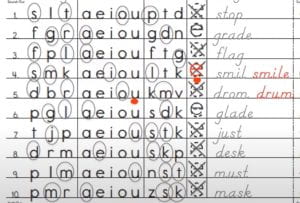As I continue to deepen my knowledge of foundational skills to support reading and disciplinary literacy, I am grateful for resources such as the Teaching foundational reading skills Part 2 webinar I recently watched. It included many useful strategies, two of which are new to me and stand out as useful for others. In this post, I want to summarize these: Sound Out Words and Fluency Practice.
Strategy 1: Sound Out Words. Reading high frequency words is evident in the standards Here are some examples of Standards including high frequency words:
The Wisconsin ELA Standard RF.K.3: Know and apply grade-level phonics and word analysis skills in decoding words. c. Read common high-frequency words by sight (e.g., the, of, to, you, she, my, is, are, do, does).
The Wisconsin ELA Standard RF.2.3 Know and apply grade-level phonics and word analysis skills in decoding words. f. Recognize and read grade-appropriate irregularly spelled words.
Approximately “300 words account for 65%” of primary students’ reading and writing (see 8:20). So it is important that we offer explicit instruction in high frequency words. Some high frequency words are regular (with common vowel sound spellings) and others are irregular. Read Naturally calls the regular words “sound out words” and what follows is a strategy for teaching these words. (Watch the webinar for strategies on “spell out words” or irregular.)
Sound Out Words Steps 10:50:
- The teacher dictates a regularly spelled high frequency word.
- The student circles a letter to represent each sound (one word is per row on the worksheet).
- If the word has a long vowel with a silent e, the student traces the dotted e. If not, the e is crossed out.
- The student writes the whole word.
- The teacher tells the student the letters and the student corrects, using a colored pencil. They put a dot under each correct letter and if there is an error they write it correctly.

Strategy 2: Fluency Practice. Fluency is also represented in the Standards. For example:
The Wisconsin ELA Standard RF.1.4 Read emergent-reader texts with purpose, understanding, and sufficient accuracy and fluency to support comprehension. b. Read grade-level text orally with accuracy, appropriate rate, and expression on successive readings.
Research indicates three ways to improve fluency: it is modeled by the teacher through Read Alouds, students engage in repeated reading, and students receive feedback on progress towards their goals (in the form of visual charts to show growth).
Fluency Practice Steps 32:38:
- Phonemic Awareness:
- Students listen for the sound that is featured in the lesson and give a thumbs up if the sound is in the word.
- Blend Sounds. The teacher provides the sounds and students blend them together.
- Phonics: The teacher shows a small number of words.
- Regular words are written in one color and students sound these words out.
- Irregular words are written in another color. Students use a strategy where they say the word, trace the word, say the word again.
- Students write a prediction about the story to help set a purpose for comprehension.
- Each student reads the story on their own, underlining unknown words. Then they graph how many words they read in a minute, in the color blue.
- Students read the story together with the teacher. They pause to decode words with the featured sound.
- Students do several repeated readings to practice the story. They continue practicing until they reach their goal for words read per minute. Once this goal is reached, they graph it in red to compare to the blue from step 4. This is very motivating for students and empowering because they are agents in their own learning. They see that practice improves fluency and understanding.
- Students answer a few questions and write a sentence. Writing provides practice in the featured sound.
It has been so helpful over the past several months to hear from others about their take-aways from these posts. I appreciate my readers and the feedback you provide, as I continue to learn alongside you. If you have ideas to add to the strategies above, I’d love to hear about them!